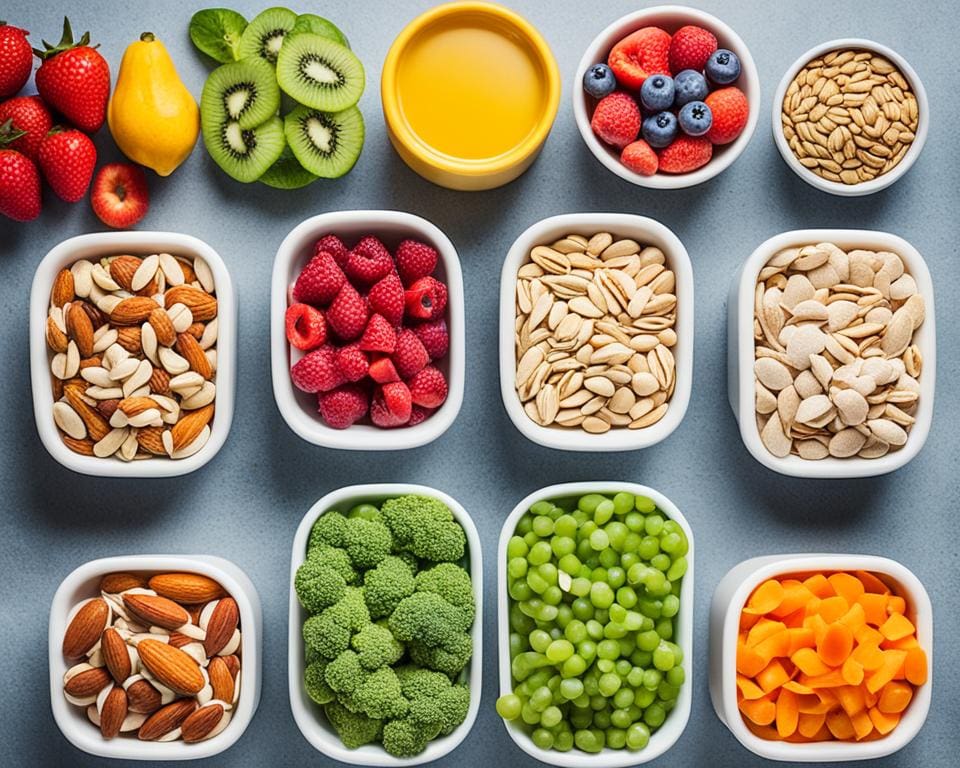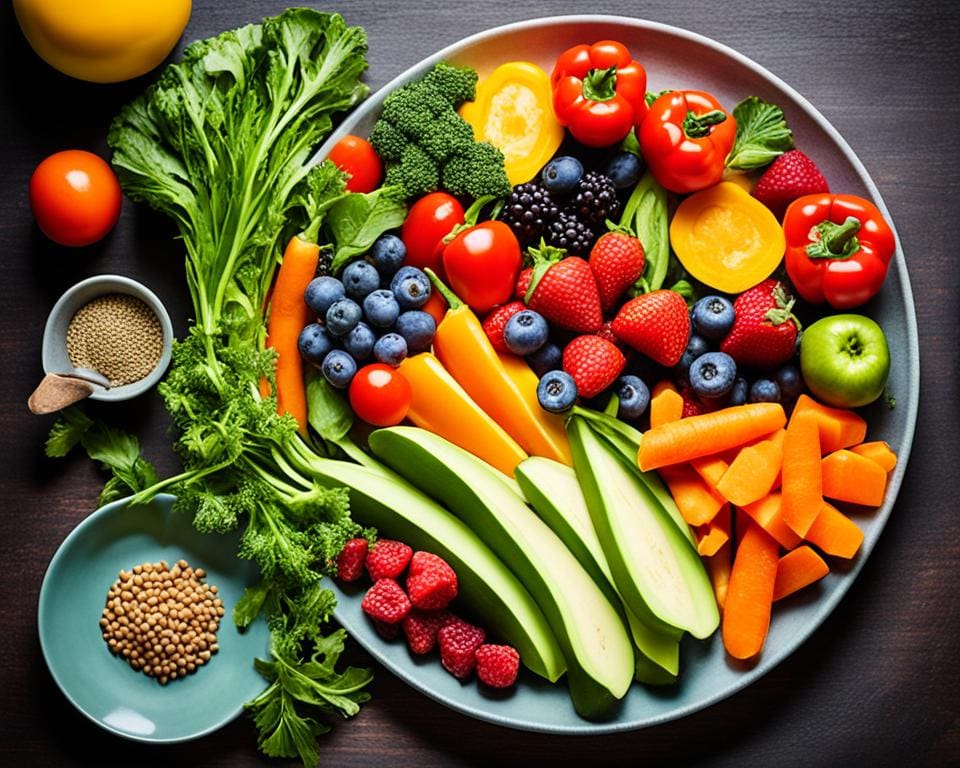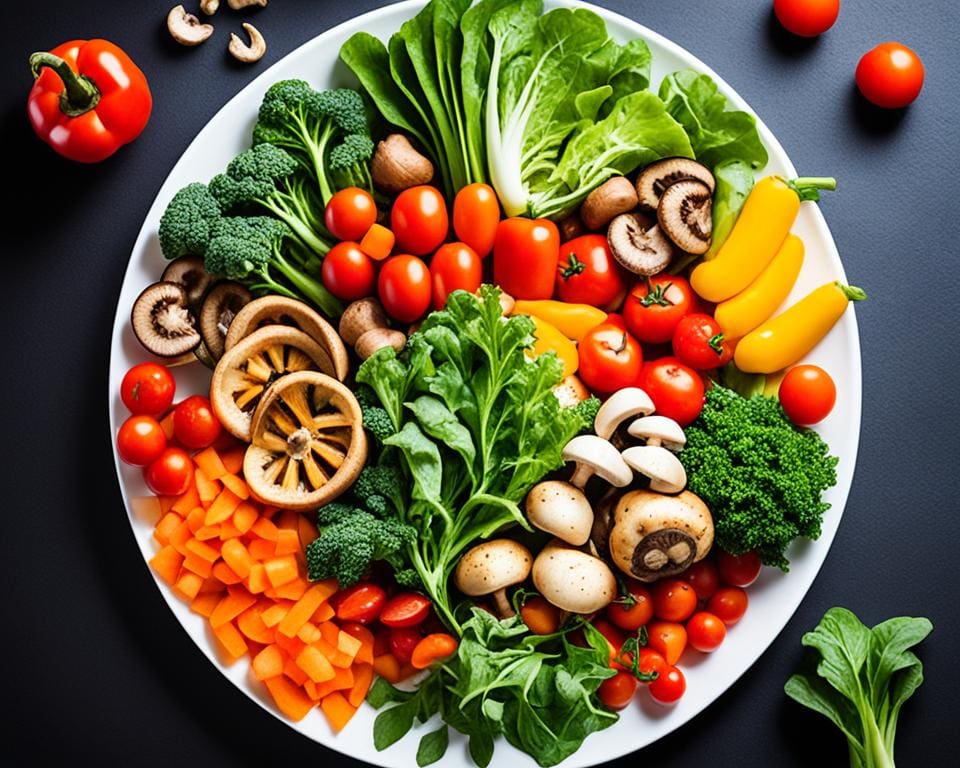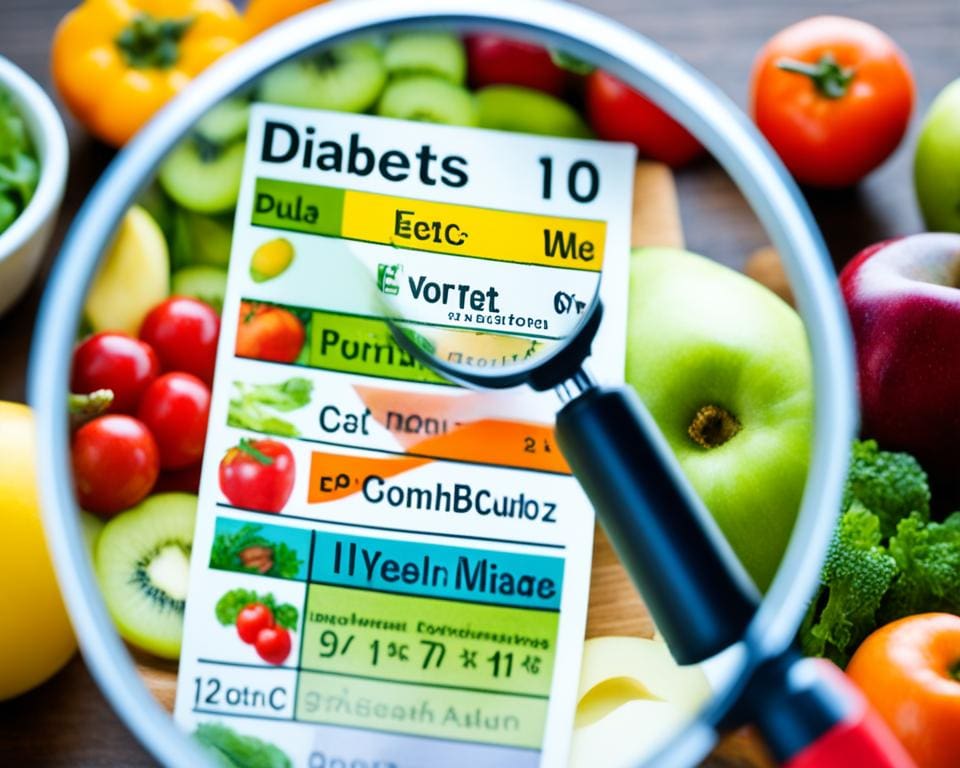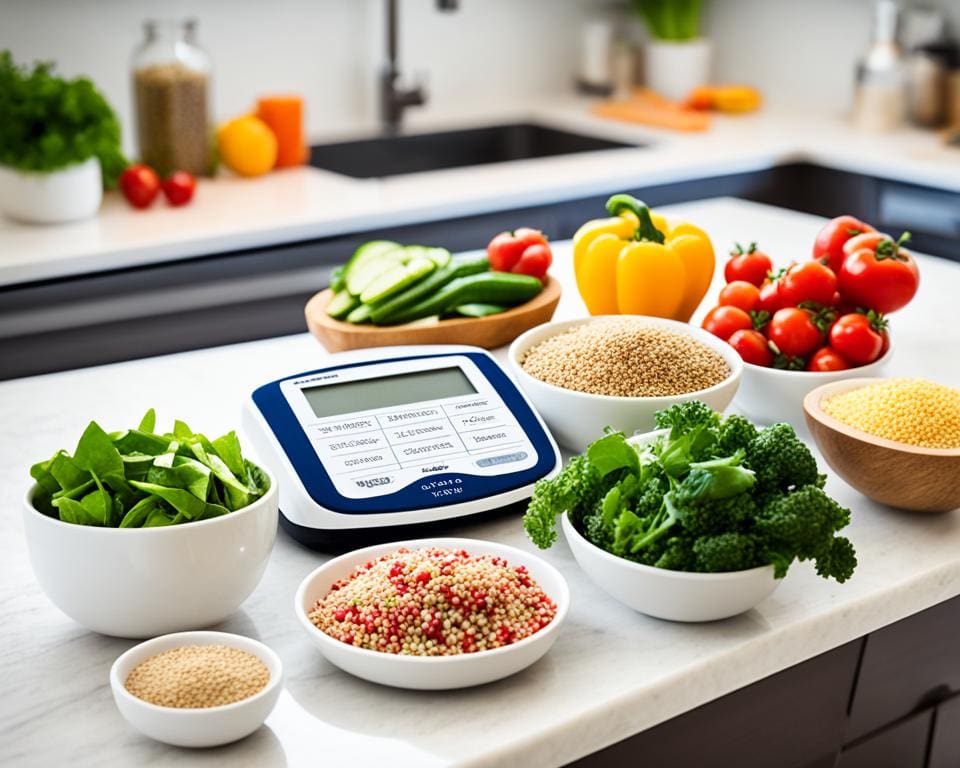In recent years, the gut microbiome has become key in fighting type 2 diabetes. About 462 million people worldwide had type 2 diabetes in 2019, making up 6.28% of the population1. Researchers are finding that a healthy gut microbiome could be the answer to reversing type 2 diabetes and better glucose control.
Studies show that people with type 2 diabetes have different gut bacteria than those without the disease1. This suggests that gut health could play a big part in both getting and reversing type 2 diabetes. More research has linked gut bacteria to type 2 diabetes, proving the connection1.
The gut microbiome also links to inflammation and type 2 diabetes, especially in obese people1. This shows how important gut health is in getting diabetes, especially with obesity. Also, how gut bacteria break down fiber affects not just diabetes but also allergies and blood cell production1.
Looking into how metformin affects the gut microbiome has been interesting. Studies show metformin could help gut health in people with type 2 diabetes1. This research highlights the need to think about gut health when treating diabetes.
Key Takeaways
- The gut microbiome plays a crucial role in the development and management of type 2 diabetes.
- Significant differences in gut microbiota composition exist between adults with type 2 diabetes and non-diabetic individuals.
- Gut health is involved in the onset of low-grade inflammation and type 2 diabetes associated with obesity.
- Metformin, a common diabetes medication, may have therapeutic effects on gut health in individuals with treatment-naive type 2 diabetes.
- Optimizing the gut microbiome holds promise for reversing type 2 diabetes and improving glucose control.
Understanding the Gut Microbiome
The gut microbiome is a complex group of microorganisms living in our gut. It’s key to our health and well-being. This group of bacteria, fungi, viruses, and other microbes affects our body in many ways, like how we process glucose and how sensitive we are to insulin2. Knowing about the gut microbiota helps us understand its role in metabolic health and type 2 diabetes.
Composition of the Gut Microbiota
The gut microbiota is full of different microorganisms, changing based on things like age, diet, genes, and where we live. It has trillions of microorganisms, mostly bacteria, with Firmicutes and Bacteroidetes being the most common2. Other important groups include Actinobacteria, Proteobacteria, and Verrucomicrobia. People with type 2 diabetes have different fungi in their gut compared to healthy people3. More diverse fungi are found in kids with type 1 diabetes than in healthy kids3.
Factors Influencing Gut Microbiome Health
Many things can change the gut microbiota, affecting our metabolic health and type 2 diabetes risk. These include:
- Diet: What we eat greatly affects our gut microbiome. Eating a lot of fiber, prebiotics, and fermented foods helps good bacteria grow. But eating a lot of processed foods and saturated fats can harm our gut balance2.
- Age: Our gut microbiota changes as we get older, most during infancy and in old age2.
- Genetics: Our genes can shape our gut microbiota, with some genes linked to type 2 diabetes risk2.
- Medications: Some drugs, like antibiotics and metformin, can change our gut microbiome. Metformin, a type 2 diabetes drug, changes the gut microbiome in people with type 2 diabetes, helping it work3.
- Obesity: Being overweight changes the fungi in our gut, which might lead to insulin resistance and type 2 diabetes34.
By knowing what affects the gut microbiota, we can work on making our gut healthier. This can help improve how we process glucose and lower the risk of type 2 diabetes.
The Link Between Gut Health and Type 2 Diabetes
Recent years have shown a strong link between gut health and Type 2 diabetes. With over 537 million people worldwide affected5, scientists are looking into how the gut microbiome affects diabetes. They want to know how it helps or hinders the disease.
Intestinal Dysbiosis and Insulin Resistance
People with Type 2 diabetes often have an imbalance in their gut bacteria, known as intestinal dysbiosis. This imbalance makes it harder for the body to use insulin well and control blood sugar levels. Studies show that those with diabetes have fewer types of gut bacteria, which might lead to diabetes and lower insulin use6.
Some gut bacteria are linked to how well the body uses insulin. For example, more Coprococcus means better insulin use. But more Flavonifractor means worse insulin use5. This shows how complex the relationship between gut bacteria and health is.
Inflammation and Metabolic Dysfunction
The gut microbiome helps control inflammation and how the body uses energy. In diabetes patients, the gut can be less secure, letting toxins into the blood. This can make inflammation worse and lead to insulin resistance and other health issues6.
“The gut microbiota plays a crucial role in metabolic function, especially in the context of diabetes management.” (Sharma & Tripathi, 2019)6
Changes in genes, diet, or activity levels don’t fully explain the rise in obesity and diabetes. The gut microbiome is now seen as a key factor in these conditions.
Research found 10 bacteria linked to stable blood sugar levels5. These findings suggest new ways to improve gut health and metabolic health.
| Bacteria Associated with Higher Insulin Sensitivity | Bacteria Associated with Lower Insulin Sensitivity |
|---|---|
| Coprococcus | Flavonifractor |
| Bifidobacterium | Prevotella copri (certain strains) |
By studying how gut health, inflammation, and metabolic disorders interact, experts can find new ways to prevent and treat Type 2 diabetes. Improving gut health through diet, probiotics, and lifestyle changes could help manage this chronic condition and boost overall health.
Diagnostic Tools for Assessing Gut Health in Diabetes
To manage and possibly reverse type 2 diabetes, checking your gut microbiome health is key. There are tools to look at your gut bacteria. These are important for how your body handles glucose and insulin.
Stool sample testing is a top way to check your gut microbiome. It looks at the bacteria in your stool to find signs linked to diabetes. A study found 12 markers that could help spot type 2 diabetes, showing a strong link7.
This study looked at 91 samples, with 44 from people with diabetes and 47 from healthy folks7. It found certain bacteria were more common in those with diabetes. This matches what other studies have shown about diabetes and gut bacteria78.
Another key test is the glucose tolerance test. It checks how well your body handles sugar. By looking at your blood sugar before and after a sugary drink, doctors can see how your body uses glucose.
Using both gut microbiome analysis and glucose tolerance testing gives a full picture of how your gut affects your diabetes risk.
Other tests help check gut health in diabetes too:
- Genova’s GI Effects stool test looks at microbial balance and SCFA production8
- Cyrex’s Array 2 checks biomarkers for gut wall health8
- Precision Point’s Advanced Oxidative Stress test looks at glutathione levels and damage markers8
- Salivary Adrenal Panel by Genova checks cortisol levels for stress effects on blood sugar8
| Diagnostic Tool | Purpose |
|---|---|
| Stool Sample Testing | Looks at gut microbiome and finds markers linked to diabetes |
| Glucose Tolerance Test | Checks how well your body handles insulin and glucose |
| GI Effects Stool Test | Shows gut balance and SCFA production |
| Cyrex’s Array 2 | Looks at biomarkers for gut wall health and glucose metabolism |
Using these tools and working with your doctor helps you understand your gut’s role in diabetes. This lets you make changes like eating differently or taking probiotics. These can help keep your gut healthy and control your blood sugar better.
Dietary Interventions for Improving Gut Health
Making smart food choices can greatly improve gut health and help manage type 2 diabetes. Eating foods rich in prebiotic fiber, fermented foods, and low-glycemic carbs helps good gut bacteria grow. This can also help control blood sugar levels. Studies show that working with a dietitian can lower A1C levels by 0.3–2.0% for people with type 2 diabetes9.

High-Fiber, Low-Glycemic Diet
Eating foods high in fiber and low on the glycemic index helps grow diverse gut bacteria and makes insulin work better. Fiber is linked to fewer diseases, better health, and lower cholesterol and blood pressure9. Foods like onions, chicory root, oats, bananas, and Jerusalem artichokes are great sources of prebiotic fiber. They feed the good gut bacteria, helping them grow and work better.
When planning your diet, think about the balance of carbs, proteins, and fats. Experts say a wide range of carbs can help manage diabetes. But eating too many carbs or too few can be bad for your health.
Prebiotics and Probiotics
Adding prebiotics and probiotics to your meals can boost gut health and help control blood sugar. Prebiotics feed the good bacteria in your gut. Probiotics are live bacteria that can fix an unbalanced gut. Eating these can help with weight and blood sugar control in type 2 diabetes10.
Fermented Foods
Foods like kefir, sauerkraut, kombucha, tempeh, and kimchi are full of probiotics. They help improve gut health. These foods are made through fermentation, which supports the growth of beneficial bacteria. Eating these foods often can keep your gut microbiome diverse and strong, which is key for health and managing blood sugar.
By focusing on prebiotic fiber, fermented foods, and low-glycemic carbs, you can help your gut bacteria thrive. Eating more whole grains, fruits, vegetables, and legumes can make your gut microbiome more diverse. This reduces harmful bacteria and inflammation10. Stick with these changes to see long-term improvements in gut health and diabetes management.
Lifestyle Modifications for Gut Health
Changing your lifestyle can greatly help your gut health and prevent diabetes. Adding regular exercise and stress-reducing activities to your day can make a big difference. These changes can improve your gut’s balance and boost your health.
Regular Physical Activity
Exercise helps increase good gut bacteria and makes your body more sensitive to insulin11. It also helps with weight control and keeps your gut healthy. Try to do different exercises like walking, jogging, cycling, or lifting weights each week. This is good for your gut and helps prevent diabetes.
Regular exercise is like a natural probiotic for your gut, promoting the growth of beneficial bacteria and enhancing overall health.
Stress Management Techniques
Too much stress can harm your gut’s balance, leading to fewer good bacteria11. To fight this, add stress-reducing activities to your day. Here are some ideas:
- Meditation: Practice mindfulness meditation to calm your mind and reduce stress levels.
- Yoga: Engage in gentle yoga poses to promote relaxation and improve gut motility.
- Deep breathing exercises: Take a few minutes each day to focus on deep, diaphragmatic breathing to alleviate stress and promote a sense of tranquility.
- Time in nature: Spend time outdoors, surrounded by nature, to reduce stress and boost your mood.
Stress management helps create a better home for good gut bacteria. This supports your efforts to prevent and manage diabetes11.
| Lifestyle Modification | Benefits for Gut Health | Impact on Diabetes Prevention |
|---|---|---|
| Regular Physical Activity | Increases beneficial gut bacteria | Improves insulin sensitivity |
| Stress Management Techniques | Restores gut microbiome balance | Reduces inflammation and supports glucose control |
By making these lifestyle changes and eating well, you can improve your gut health. This can lead to better health overall and help prevent type 2 diabetes.
Targeted Probiotic Supplementation
The number of people with type 2 diabetes is expected to grow from 10.5% in 2021 to 12.2% by 204512. This shows we need better ways to manage it. Studies now suggest that targeted probiotic supplements could help control blood sugar and improve insulin levels in people with type 2 diabetes.

Studies have looked into how probiotics affect people with type 2 diabetes13. They found that probiotics can help with blood sugar and cholesterol levels13. A review of 33 studies showed that most found probiotics helped with blood sugar and cholesterol in people with type 2 diabetes12.
Beneficial Bacterial Strains for Diabetes Management
Some bacteria strains could be key in managing type 2 diabetes. A study found a special probiotic mix helped people with type 2 diabetes13. Another study showed that certain Lactobacillus strains also helped13.
Probiotics can improve gut health and help manage type 2 diabetes when taken in the right amounts12. A review found that people with type 2 diabetes have different gut bacteria than healthy people1312.
Probiotics were found to reduce bacterial translocation in type 2 diabetes mellitus patients in a randomized controlled study13.
Synbiotics, which are a mix of probiotics and prebiotics, also show promise. People with type 2 diabetes who ate synbiotic bread had better cholesterol levels13. A study found that eating synbiotic bread daily helped with insulin levels and a marker of inflammation in diabetics13.
It’s important to note that not all studies showed clear benefits in blood sugar, cholesterol, or blood pressure levels12. But, taking probiotics with metformin did improve blood sugar levels in people with type 2 diabetes12.
As we learn more about the link between gut health and type 2 diabetes, targeted probiotic supplements could be a helpful addition to managing the condition.
Fecal Microbiota Transplantation: An Emerging Therapy
Fecal microbiota transplantation (FMT) is a new way to help people with gut microbiome restoration and diabetes treatment. With type 2 diabetes affecting 370 million people worldwide and expected to double by 203014, finding new treatments like FMT is crucial.
Studies show that gut health and type 2 diabetes are closely linked. People with type 2 diabetes often have less good bacteria and more bad bacteria in their gut15.
FMT might help make insulin work better and lower blood sugar in people with type 2 diabetes15. In tests, FMT helped people with type 2 diabetes control their blood sugar better and made their gut bacteria healthier14. A study with 31 new type 2 diabetes patients found that FMT changed their gut bacteria for the better14.
Chlorobium phaeovibrioides, Bifidobacterium adolescentis, and Synechococcus sp.WH8103 were identified as potential key species due to their significantly negative correlations with HOMA-IR14.
FMT could be a new way to help manage diabetes by changing gut bacteria. These bacteria affect diabetes by making certain substances that can harm or help the body16. Giving mice butyrate, a type of gut bacteria, helped prevent diabetes and obesity16.
Even though FMT looks promising, we need more studies to know how safe and effective it is long-term. Making FMT fit each patient’s gut bacteria could make it even more helpful in fighting type 2 diabetes and its complications.
The Impact of Medications on Gut Microbiome
Exploring the link between gut health and type 2 diabetes shows us how important it is to look at how medications affect the gut microbiome. Diabetes drugs and antibiotics can change the balance of gut bacteria. This can affect how well diabetes is managed.

Research has found that certain diabetes drugs change the types of bacteria in the gut. For example, metformin can make some bacteria more common and others less common17. This can affect how well the body controls blood sugar levels.
Metformin and Gut Bacteria
Metformin is a common diabetes drug that has been studied a lot for its effects on gut bacteria. Studies show it can change the types of bacteria in the gut in people with type 2 diabetes18. This can lead to more good bacteria and less bad bacteria, which helps control blood sugar levels18.
Metformin also helps make short-chain fatty acids, which are good for the gut and can help control diabetes17. This shows that changing the gut bacteria could be a way to prevent or treat diabetes18.
Antibiotics and Microbiome Disruption
Antibiotics can greatly affect the gut microbiome, leading to an imbalance that might increase diabetes risk. This imbalance can last a long time and affect overall health. Changes in gut bacteria can even show if someone is getting glucose intolerant18.
The way gut bacteria and diabetes drugs work together is complex. It affects how well the drugs work and how safe they are17. Looking at the link between gut health and diabetes shows we need a personalized approach to managing diabetes. This includes considering each person’s gut bacteria.
Gut-Derived Metabolites and Their Role in Diabetes
Research has shown a strong link between gut health and type 2 diabetes. Gut-derived metabolites, made by the gut’s microorganisms, are key in managing glucose and insulin levels19. These include short-chain fatty acids (SCFAs) and bile acids, which are vital for diabetes prevention and treatment19.
Short-Chain Fatty Acids (SCFAs)
SCFAs, like acetate, propionate, and butyrate, come from fermenting fiber by gut bacteria19. They help with glucose and insulin levels. SCFAs keep the gut lining healthy, manage immune responses, and help insulin-producing cells grow and work better19. Studies show that more SCFAs are linked to better glucose control and lower diabetes risk19.
Obesity and type 2 diabetes change SCFA levels, affecting glucose and insulin20. Studies found that a changed gut microbiome in diabetes affects metabolism and insulin action in different body parts19.
Bile Acids and Glucose Metabolism
Bile acids come from liver-made cholesterol and get changed by gut bacteria19. These changes make secondary bile acids like deoxycholic acid and ursodeoxycholic acid (UDCA)19. Bile acids are key for glucose and fat metabolism, helping with diabetes prevention and treatment21.
Changes in bile acid metabolism from gut imbalance can harm glucose and insulin levels21. Fixing the gut microbiome to improve bile acid signals could be a new way to treat type 2 diabetes.
| Microbial Metabolite | Role in Glucose Metabolism | Potential Therapeutic Implications |
|---|---|---|
| Short-Chain Fatty Acids (SCFAs) | Promote insulin sensitivity, regulate glucose homeostasis | Dietary interventions to increase SCFA production |
| Bile Acids | Modulate glucose and lipid metabolism | Targeting bile acid signaling pathways |
| Lipopolysaccharide (LPS) | Contributes to inflammation-induced insulin resistance | Strategies to reduce LPS levels and inflammation |
We can measure these metabolites in blood, urine, feces, and the colon, helping us understand their effects on health and diabetes19. As we learn more about gut metabolites and diabetes, new treatments targeting the gut microbiome could help prevent and manage diabetes1921.
Microbiome-Targeted Therapies for Diabetes Complications
The number of people with diabetes is growing fast, with 463 million cases in 2019 and expected to hit 700 million by 204522. We need new ways to manage diabetes and its complications. Gut microbiome treatments are showing promise, especially for kidney and heart issues.
Our gut is home to trillions of bacteria from over 1000 species22. These bacteria are key to our health. When they’re out of balance, it can lead to kidney and heart problems in diabetics22. By focusing on the gut microbiome, we might lower the risk of these issues with diet changes, probiotics, and new treatments23.
Diabetic Nephropathy
About 40% of people with diabetes get kidney disease, and 20% may need dialysis22. Studies show that the gut of these patients has fewer good bacteria and more bad ones22. This imbalance can make kidney disease worse.
Probiotics could help improve kidney function in these patients22. Certain probiotics have been shown to lower harmful substances in the blood22. By fixing the gut balance, we might slow down kidney damage and boost kidney health.
Cardiovascular Disease
People with diabetes are at higher risk for heart disease. The gut microbiome plays a part in this risk23. The American Heart Association says managing heart risks is key for diabetics23. Gut treatments could help lower this risk.
New tech is helping us understand and change the gut microbiome for the better23. We’re exploring wireless sensors and edible devices to help manage diabetes23. Wearable sensors could also help diabetics take better care of themselves23.
By using these tech advances and diet changes, doctors can create custom treatments for diabetes patients. This could improve gut health and lower heart risks.
The gut microbiome is a new area in fighting diabetes complications. By focusing on gut health, we can tackle kidney and heart issues in diabetes. This could change lives.
As we learn more about the gut microbiome and diabetes, we see big potential in targeted treatments. Adding these to diabetes care could lead to better health outcomes and quality of life for diabetics.
Personalizing Gut Health Interventions
Personalized nutrition is getting more advanced, thanks to microbiome profiling. This tool helps tailor gut health plans to fit each person’s needs. With diabetes affecting 6.7% of people worldwide in 2021 and expected to rise to 10.2% by 204524, this approach could be key to fighting type 2 diabetes.
Recent studies show how diet affects our gut bacteria and health25. By using advanced microbiome profiling, doctors can find specific bacteria linked to diabetes. This lets them create treatments that work best for each person, reducing side effects.
“Personalized nutrition for the treatment of obesity and diabetes has the potential to revolutionize disease management by addressing individual genetic, metabolic, and microbial variations.” – Panduro A et al. (2020)25
Custom diets, like those high in fiber and low in sugar, can be made for each person’s gut bacteria24. These diets aim to balance gut bacteria, improve insulin use, and lower inflammation. All these are key to preventing type 2 diabetes.
Dealing with obesity might also mean specific exercise and stress management plans25. By focusing on each person’s needs, healthcare can help patients manage their metabolic health better. This could even help reverse type 2 diabetes.
| Gene | Impact on Type 2 Diabetes Risk |
|---|---|
| TCF7L2 | Influences insulin secretion and beta-cell growth25 |
| FABP2 | Polymorphisms associated with increased type 2 diabetes risk25 |
| ABCA1 | Variants impact HDL cholesterol levels and BMI25 |
As we learn more about genetics, gut bacteria, and health, personalized gut care is set to play a big role in fighting type 2 diabetes. By using microbiome profiling and custom treatments, doctors can help millions of people worldwide.
Future Directions in Gut Microbiome Research for Diabetes
The number of people with diabetes is growing worldwide. In 2022, about 28.7 million Americans had Type 1 or Type 2 diabetes26. Researchers are now looking at the gut microbiome for new ways to prevent and treat diabetes. They want to use the gut microbiome for diagnostics, therapies, and better nutrition.

They aim to find certain microbes linked to diabetes risk and treatment response. This could lead to early detection and tailored treatments. By studying the gut microbiome’s genes and how it interacts with our metabolism27, scientists hope to create new therapies. These therapies could help manage diabetes and prevent complications.
Targeted nutrition is also a key area for preventing and managing diabetes. Studies show how diet affects our gut and health27. For example, eating more whole grains can help with weight and inflammation without changing the gut microbiome much27. This means we might be able to use diet to keep the gut healthy and prevent diabetes.
The gut mycobiome, mainly made up of Saccharomycetes and Saccharomyces26, is also being studied for diabetes. Researchers found 34 out of 43 fungal types in many people26. Looking into gut fungi could reveal new ways to understand and treat diabetes.
Diabetes is expected to cost the US about USD 825 billion by 203026. So, studying the gut microbiome for diabetes is crucial for health and the economy. By learning more about how our gut microbiome affects diabetes, we can create new treatments and nutrition plans. This could help stop the diabetes epidemic and improve lives worldwide.
Clinical Trials and Real-World Evidence
Researchers are looking into how the gut microbiome can help reverse type 2 diabetes. Clinical trials and real-world evidence are key to proving these treatments work and are safe. Studies by Schneeweiss S and Patorno E28 show how different treatments do in real life.
Future studies will look at how therapies like probiotics and dietary changes affect diabetes. Taur SR28 talks about the need for good studies to get reliable data.
Comparing real-world data with trial results is important. Elliott L, Fidler C, Ditchfield A, and Stissing T looked at how often hypoglycemia happened in real life versus in trials28. This helps us understand how research matches up with what happens in everyday life.
Success Stories of Reversing Type 2 Diabetes Through Gut Health
People who have reversed their type 2 diabetes through gut health inspire others. Their stories show how therapies and lifestyle changes can make a big difference.
“After years of struggling with type 2 diabetes, I decided to focus on improving my gut health through a combination of dietary changes and targeted probiotic supplementation. Within months, my blood sugar levels stabilized, and I was able to reduce my medication. It’s been a life-changing experience.”
Edridge CL, Dunkley AJ, Bodicoat DH, et al. looked at how often hypoglycemia happens in people with type 2 diabetes28. Their big study shows we need to think about the risk of low blood sugar when managing diabetes, including gut microbiome treatments.
| Microbiome Intervention | Potential Benefits for Type 2 Diabetes |
|---|---|
| High-fiber, low-glycemic diet | Promotes beneficial gut bacteria, improves insulin sensitivity |
| Prebiotics and probiotics | Supports healthy gut microbiome composition, reduces inflammation |
| Fecal microbiota transplantation | Introduces healthy gut bacteria, may improve glucose metabolism |
As we learn more about the gut microbiome and type 2 diabetes, more people can take charge of their health. This includes using targeted treatments and making lifestyle changes.
Strategies to Reverse Type 2 Diabetes by Optimizing Gut Health
Reversing type 2 diabetes involves fixing the gut microbiome with a mix of diet changes, lifestyle tweaks, and specific treatments. Up to 37% of people with prediabetes might get type 2 diabetes within 4 years29. Since the 1980s, type 2 diabetes has tripled in America30. The IDF Diabetes Atlas from 2017 shows how diabetes affects people worldwide31.

Important ways to prevent diabetes include eating a lot of fiber and less sugar. Foods high in refined carbs and sugar can raise blood sugar and insulin levels, making diabetes more likely29. Americans eat about 152 pounds of sugar and 146 pounds of flour each year30.
Regular exercise and managing stress are key for managing diabetes. Exercise helps balance blood sugar and insulin levels, with HIIT being especially good for Type 2 diabetes and obesity30. The Centers for Disease Control and Prevention’s 2017 report gives vital stats on diabetes in the U.S31..
Losing 5-7% of your weight can really cut the risk of type 2 diabetes if you’re overweight or have prediabetes29.
Supplements tailored to your needs can also help improve gut health. Studies show that the gut microbiota helps with metabolic benefits after weight loss surgery, showing how important gut health is for diabetes31. Experts talked a lot about metabolic surgery’s role in treating Type 2 diabetes31.
- Work with health experts like doctors, dietitians, and diabetes educators to help you reverse diabetes.
- Keep track of your progress, as research shows tracking helps you lose more weight than not tracking at all30.
| Dietary Strategies | Lifestyle Modifications | Targeted Interventions |
|---|---|---|
| High-fiber, low-glycemic diet | Regular physical activity | Probiotic supplementation |
| Prebiotic and probiotic foods | Stress management techniques | Targeted nutrition therapy |
| Fermented foods | Adequate sleep | Personalized gut health interventions |
By using these strategies and working with health experts, you can improve your gut health and help reverse type 2 diabetes. Studies show that better glucose metabolism after weight loss surgery is linked to more bile acid and changes in the gut microbiome31. This shows how targeted treatments can help manage diabetes.
Conclusion
The study of the gut microbiome has shown how important gut health is for fighting type 2 diabetes. With diabetes cases rising from 108 million in 1980 to 422 million in 2014, finding new ways to help is crucial32. The gut microbiome, full of trillions of microorganisms, helps control insulin levels, glucose, and overall health.
By eating foods high in fiber and low in sugar, taking prebiotics and probiotics, and eating fermented foods, we can improve our gut health. This helps create a balanced gut that can help reverse diabetes. Adding regular exercise and stress-reducing activities also helps keep the gut healthy. New treatments like giving specific bacteria or fecal microbiota transplantation show promise in fighting diabetes.
As we learn more about the gut microbiome and diabetes, we’ll see more personalized treatments. The DiRECT trial showed that losing weight helped 9 out of 10 people reverse their diabetes32. By focusing on gut health, we can help millions worldwide overcome type 2 diabetes and improve their lives.
FAQ
How does gut health influence the development and management of type 2 diabetes?
Gut health is key to managing type 2 diabetes. An imbalance in gut bacteria, called intestinal dysbiosis, can lead to inflammation and insulin resistance. By improving gut health, we can better control blood sugar levels and manage diabetes.
What dietary changes can help improve gut health and reverse type 2 diabetes?
Eating more fiber and choosing low-carb foods helps gut health and diabetes. Foods like onions, chicory root, and bananas boost good gut bacteria. Fermented foods like kefir and sauerkraut also help. These changes can lower blood sugar and improve health.
How can lifestyle modifications support gut health and diabetes management?
Being active and managing stress helps the gut and diabetes. Exercise boosts good gut bacteria and makes insulin work better. Stress can harm gut health, but practices like meditation can help. These changes work well with diet to improve gut health and diabetes.
What role do probiotics play in diabetes management and glucose control?
Probiotics can help manage diabetes and control glucose. Strains like Bifidobacterium and Lactobacillus improve insulin sensitivity. They balance gut bacteria and help with glucose metabolism. Always talk to a doctor before starting probiotics.
Can medications impact the gut microbiome and influence diabetes management?
Yes, some medicines like antibiotics and metformin can change gut bacteria. Metformin, a diabetes drug, changes gut bacteria in a good way. But antibiotics can harm gut health. Always talk to a doctor about how medicines affect gut health.
What are some success stories of individuals who have reversed their type 2 diabetes through gut health interventions?
Many people have turned their type 2 diabetes around by focusing on gut health. They changed their diet, exercised, and managed stress. These stories show it’s possible to manage diabetes through gut health. Working with health experts helps make this journey successful.
Source Links
- https://www.ncbi.nlm.nih.gov/pmc/articles/PMC8384524/
- https://www.frontiersin.org/journals/endocrinology/articles/10.3389/fendo.2021.632335/full
- https://www.ncbi.nlm.nih.gov/pmc/articles/PMC8747253/
- https://www.technologynetworks.com/analysis/articles/using-gut-bacteria-to-treat-diabetes-378572
- https://medicalxpress.com/news/2024-06-links-gut-microbiome-diabetes.html
- https://quasdrinks.co.uk/blogs/posts/gut-health-type-2-diabetes-mellitus-all-you-need-to-know
- https://www.ncbi.nlm.nih.gov/pmc/articles/PMC8810174/
- https://www.rupahealth.com/post/functional-medicine-for-managing-gut-health-in-patients-with-diabetes
- https://www.ncbi.nlm.nih.gov/books/NBK279012/
- https://www.ncbi.nlm.nih.gov/pmc/articles/PMC5111532/
- https://www.healthline.com/health/gut-health
- https://www.ncbi.nlm.nih.gov/pmc/articles/PMC10648673/
- https://www.ncbi.nlm.nih.gov/pmc/articles/PMC10324246/
- https://www.ncbi.nlm.nih.gov/pmc/articles/PMC9872724/
- https://www.frontiersin.org/journals/cellular-and-infection-microbiology/articles/10.3389/fcimb.2019.00455/full
- https://www.dovepress.com/fecal-microbiota-transplantation-a-prospective-treatment-for-type-2-di-peer-reviewed-fulltext-article-DMSO
- https://www.ncbi.nlm.nih.gov/pmc/articles/PMC9194476/
- https://www.ncbi.nlm.nih.gov/pmc/articles/PMC9350729/
- https://www.mdpi.com/1422-0067/22/23/12846
- https://www.ncbi.nlm.nih.gov/pmc/articles/PMC10204722/
- https://www.ncbi.nlm.nih.gov/pmc/articles/PMC10405753/
- https://www.mdpi.com/2072-6643/14/1/166
- https://www.ncbi.nlm.nih.gov/pmc/articles/PMC10824172/
- https://www.ncbi.nlm.nih.gov/pmc/articles/PMC9402911/
- https://www.ncbi.nlm.nih.gov/pmc/articles/PMC9167367/
- https://www.ncbi.nlm.nih.gov/pmc/articles/PMC10312434/
- https://www.ncbi.nlm.nih.gov/pmc/articles/PMC10698456/
- https://www.ncbi.nlm.nih.gov/pmc/articles/PMC10499769/
- https://www.healthline.com/nutrition/prevent-diabetes
- https://drhyman.com/blogs/content/7-ways-reverse-obesity-diabetes
- https://www.ncbi.nlm.nih.gov/pmc/articles/PMC6520897/
- https://www.medicalnewstoday.com/articles/327390








